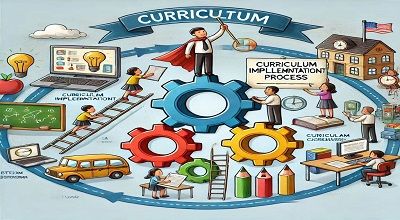Curriculum Implementation Process
The curriculum implementation process is a series of steps and activities designed to put a curriculum into practice in an educational setting. It involves translating the curriculum design. Which is the theoretical framework and content structure, into actual teaching and learning experiences. The process varies across educational institutions, but generally includes the following key stages:
Curriculum Planning:
- Needs Assessment: Identify the educational needs of the students and the community.
- Setting Objectives: Define clear and measurable learning objectives that align with educational goals.
- Curriculum Design: Develop a curriculum framework that outlines the structure, content, and sequence of the educational program.
Resource Allocation:
- Budgeting: Allocate resources, including finances, personnel, and materials, required for curriculum implementation.
- Facilities and Infrastructure: Ensure that the physical infrastructure and facilities are conducive to effective teaching and learning.
Teacher Training and Development:
- Professional Development: Provide training for teachers to familiarize them with the curriculum goals, content, and instructional methods.
- Workshops and Seminars: Conduct workshops and seminars to enhance teachers’ pedagogical skills and subject knowledge.
Development of Teaching and Learning Materials:
- Textbooks and Resources: Develop or select textbooks and supplementary materials that align with the curriculum.
- Technology Integration: Incorporate technology and multimedia resources as appropriate.
Implementation:
- Lesson Planning: Teachers create lesson plans based on the curriculum objectives.
- Instructional Strategies: Implement various teaching methods and strategies to engage students and facilitate learning.
- Assessment: Use formative and summative assessments to evaluate student progress and adjust teaching strategies accordingly.
Monitoring and Evaluation:
- Feedback Mechanisms: Establish mechanisms for collecting feedback from teachers, students, and parents.
- Continuous Improvement: Use feedback to make ongoing improvements to the curriculum and teaching methods.
Adaptation and Flexibility:
- Flexibility in Implementation: Be open to adapting the curriculum based on the needs and feedback from students and teachers.
- Responsive Changes: Make adjustments to the curriculum as needed, taking into account changes in educational trends or societal needs.
Feedback and Review:
- Continuous Review: Regularly review the curriculum’s effectiveness in achieving learning outcomes.
- Stakeholder Involvement: Involve various stakeholders, including teachers, students, parents, and administrators, in the review process.
Communication:
- Communication Channels: Establish effective communication channels to keep all stakeholders informed about the curriculum and its implementation.
- Parental and Community Involvement: Encourage the involvement of parents and the local community in supporting the curriculum.
Documentation and Reporting:
- Record Keeping: Maintain records of curriculum implementation, including assessments, feedback, and changes made.
- Reporting: Provide regular reports on the progress and outcomes of the curriculum implementation to relevant stakeholders.
Note:
By following these steps, educational institutions can ensure a systematic and effective implementation of the curriculum, ultimately contributing to the quality of education provided to students.
